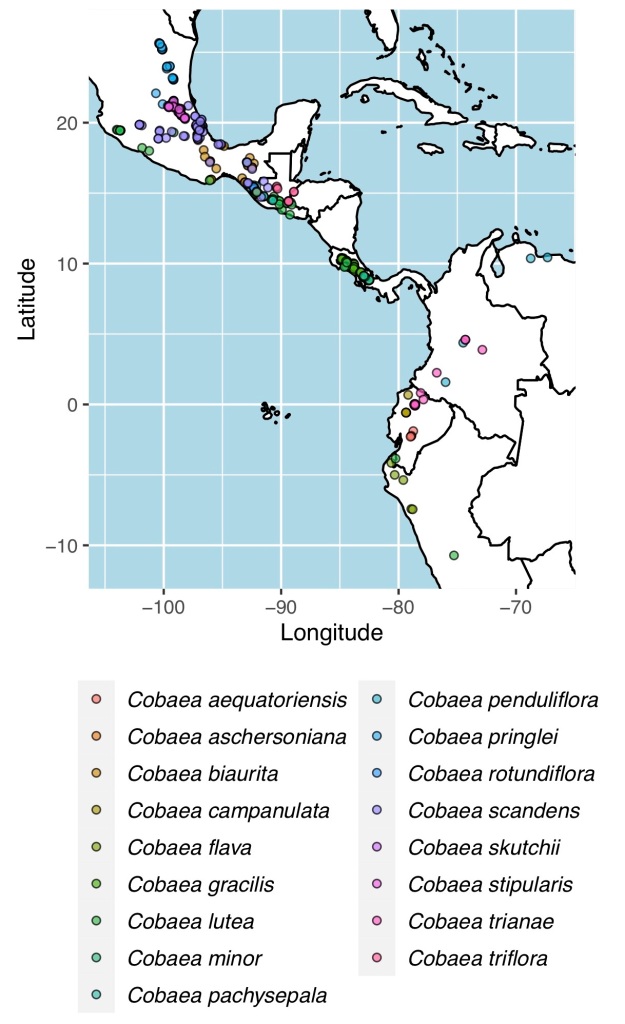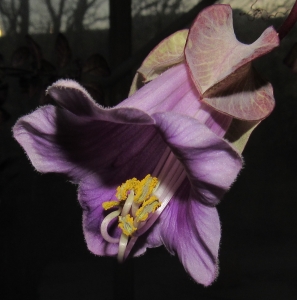Cobaea is a genus of 18 species of lianas native to the tropics in Central and South America. While Cobaea pollinated by a diversity of animals including hawkmoths and hummingbirds, the most charismatic and well known pollinator are bats. This was first suggested when claw marks were noticed on the outside of the corolla, and has since been confirmed in species such as C. aschersoniana (Ippolito & Suarez 1998). Cobaea scandens, another bat-pollinated species, is sometimes cultivated and may escape in tropical areas including New Zealand. Because it is escaped in Central and South America, its native range is hard to delimit.
The flowers of Cobaea are strikingly convergent with other bat-pollinated clades including Amphitecna (Bignoniaceae) and Macrocarpaea (Gentianaceae). Indeed, Cobaea was originally placed in Bignoniaceae. Cobaea is so morphologically dissimilar from other Polemoniaceae that it was long placed in its own family, Cobaeaceae. It is closely related to the similarly tropical and largely hummingbird-pollinated genus Cantua. However, molecular evidence indicates that Cobaea is most closely related to the bee-pollinated Mexican genus Bonplandia.
Subgeneric classifications in Cobaea relied heavily on floral traits such as corolla lobe shape, inflorescence position, and stamen length. However, molecular data suggests that such classifications based on such traits are not reliable (Prather & Jansen 1998). Further investigation by Prather (1999a) suggested that floral (as well as many vegetative) characters are highly labile in Cobaea are highly liable. Based on the results of Prather & Jansen (1998), Prather (1999b) recognized four sections in Cobaea: sects. Cobaea, Pachysepalae, Rosenbergia, and Triovulatae.
Phylogeny
The first comprehensive phylogeny of Cobaea was that of Prather & Jansen (1998) using ITS sequences. Sect. Triovulatae was placed sister to the rest of the genus, while sect. Cobaea was placed as sister to a weakly supported clade formed by sect. Pachysepalae + sect. Rosenbergia. In addition, the monophyly of sect. Rosenbergia and its major clades were unclear. Prather & Jansen (1998) recovered all species as monophyletic except for C. biaurita and C. lutea, although species monophyly (or lack thereof) should be investigated more fully given that the finding of non-monophyly was based on results from a single marker.
Rose & Sytsma (2021) essentially reanalyzed the dataset of Prather & Jansen (1998), adding a few scattered sequences from the plastid genome. Not surprisingly, their results were almost identical, but with greater support for the monophyly of sect. Rosenbergia. Topological differences included placing C. skutchii sister to the C. campanulata + C. lutea clade instead of the C. ascehersoniana + C. gracilis clade, as well as different relationships among C. aschersoniana, C. gracilis, and C. pendula. All these differences seem to be due to lack of phylogenetic information for these relationships in the ITS region.

Biogeography

Cobaea is restricted to Mexico and northern South America. One species, C. pringlei, nearly reaches southern Texas. Prather (1999b) suggested an origin for the genus in the Mexican Highlands with two independent migrations to South America.
Taxonomy
- Cobaea aequatoriensis Asplund
- Cobaea aschersoniana Brand
- Cobaea biaurita Standley
- Cobaea campanulata Hemsl.
- Cobaea flava Prather
- Cobaea gracilis (Oersted) Hemsl.
- Cobaea lutea D. Don
- Cobaea minor M. Martens & Galeotti
- Cobaea pachysepala Standley
- Cobaea paneroi Prather
- Cobaea penduliflora (Karst.) Hook. f.
- Cobaea pringlei (House) Standley
- Cobaea rotundiflora Prather
- Cobaea scandens Cav.
- Cobaea skutchii I.M. Johnst.
- Cobaea stipularis Benth.
- Cobaea trianae Hemsl.
- Cobaea triflora Donnell Smith
KEY TO COBAEA (modified from Prather [1999b])
1. Style branches not twisted, papillae large, on adaxial surface only…2
1′. Style branches usually twisted, papillae short, distributed all over the surface…9
2. Corolla tube 15-23 mm long…C. minor
2′. Corolla tube 29-65 mm long…3
3. Filaments villous 1-2 cm below the apex; calyx coriaceous; corolla lobes sharply acute to acuminate…C. pachysepala
3′. Filaments glabrous below the apex; calyx chartaceous; corolla lobes rounded or broadly acute…4
4. Corolla white, rarely suffused with purple…C. pringlei
4′. Corolla greenish or purple, suffused with purple…5
5. Lowermost leaflet pair < 0.5× length of the upper pairs…C. stipularis
5′. Lowermost leaflet pair + equal in length to the upper pairs…6
6. Calyx lobes rounded to emarginate, rarely broadly acute; calyx (16-)19-32 mm wide…C. scandens
6′. Calyx lobes attenuate to long-acuminate; calyx 7-18 mm wide…7
7. Style 40-45 mm long; filaments adnate at base for 3-5 mm…C. paneroi
7′. Style 47-80 mm long; filaments adnate at base for (3-) 5-10 mm…8
8. Base of lowermost leaflet pair cordate to truncate; style branches 2-3 mm long…C. trianae
8′. Base of lowermost leaflet pair auriculate; style branches 3-6 mm long…C. biaurita
9. Corolla lobes < 2× as long as the tube…10
9′. Corolla lobes > 2× as long as the tube…16
10. Apex of corolla lobes rounded to acute; stamens < 55 mm long…11
10′. Apex of corolla lobes acuminate or linear; stamens > 58 mm long…15
11. Calyx margin undulate…C. skutchii
11′. Calyx margin plane…12
12. Calyx segments 8-12 mm wide; corolla lobe acute…C. rotundiflora
12′. Calyx segments 4-7 mm wide; corolla lobes rounded…13
13. Pedicels 10.5-16.0 cm long; filaments adnate at base for 8-14 mm…C. flava
13′. Pedicels 19-28 cm long; filaments adnate at base for 3-7 mm…14
14. Stems glabrous; corolla lobes 11-19 mm long…C. campanulata
14′. Stems pubescent (at least at nodes); corolla lobes 8-11 mm long…C. triflora
15. Stems, pedicels, and calyx villous; corolla lobes (27-)38-59 mm long…C. aschersoniana
15′. Stems, pedicels, and calyx glabrous to pubescent; corolla lobes 13-30 mm long…C. lutea
16. Pedicel villous; calyx densely long-ciliate…C. aequatoriensis
16′. Pedicel glabrous to puberulent; calyx glabrous or sparsely ciliate…17
17. Lowermost leaflet pair not ciliate basally; anthers 8-11 mm long…C. gracilis
17′. Lowermost leaflet pair ciliate basally; anthers 11-15 mm long…C. penduliflora
References
Ippolito, A., & Suarez, A. V. (1998). Flowering phenology and pollination of Cobaea aschersoniana (Polemoniaceae). Biotropica, 30(1), 145-148.
Prather, L. A., & Jansen, R. K. (1998). Phylogeny of Cobaea (Polemoniaceae) based on sequence data from the ITS region of nuclear ribosomal DNA. Systematic Botany, 23(1), 55-70.
Prather, L. A. (1999a). The relative lability of floral vs. non-floral characters and a morphological phylogenetic analysis of Cobaea (Polemoniaceae). Botanical Journal of the Linnean Society, 131(4), 433-450.
Prather, L. A. (1999b). Systematics of Cobaea (Polemoniaceae). Systematic Botany Monographs, 57, 1-81.
Rose, J. P., & Sytsma, K. J. (2021). Complex interactions underlie the correlated evolution of floral traits and their association with pollinators in a clade with diverse pollination systems. Evolution, 75(6), 1431-1449.

